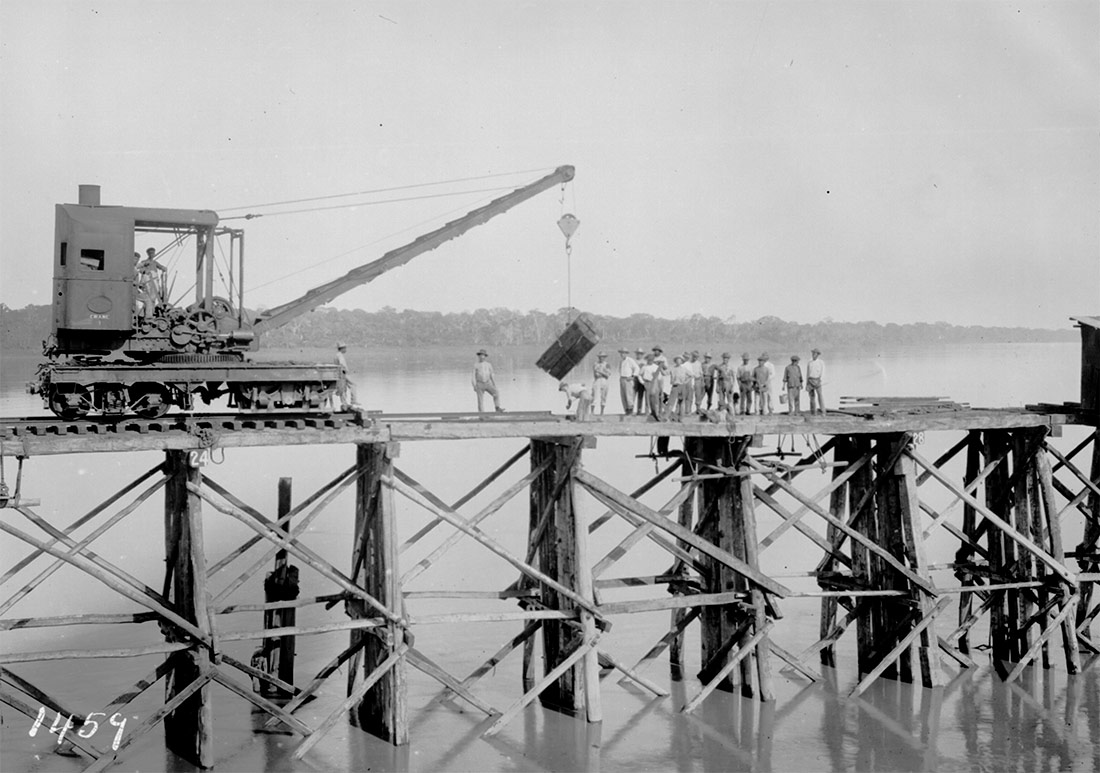
Workers carrying out construction work on a railway line. Porto Velho, 1910 | Dana Merrill, Museu Paulista da USP | Public domain
Since it came into being, the internet has been a tool for knowledge, connection and change. However, not all its effects are positive. The arrival of the internet in isolated communities, such as the Marubo in the Amazonia, is an example of how it can not only open up opportunities, but also generate concerns. The experience of these indigenous people – a mixture of enthusiasm and uncertainty – reflects a global dilemma: how to take advantage of the benefits of technology without disturbing the social balance.
Throughout the ages and across cultures, there are certain stories which seem to be repeated over and over again. These are called universal plots: narratives that reflect ideas and conflicts that are tightly interwoven with what it means to be human. Perhaps that is why the New York Times’ report on the experience of the Marubo people – an indigenous community in the Amazonian rainforest that, after centuries of relative isolation, have gained permanent internet access thanks to Elon Musk’s Starlink satellite connection service – makes for such a fascinating read.
The effects of this sudden access come as no surprise. The Marubo are now able to communicate with relatives in other regions, coordinate with distant communities, enjoy easier access to healthcare, education and economic opportunities, and even report illegal deforestation activities. However, at the same time, new concerns have arisen. Some community members have begun to hide away with their phones to the detriment of interacting with their neighbours, and others spend too much time on social media. Adults fear the impact of violent video games and pornography on young people, as well as the risk of online scams. In short, there is a growing sense that the internet is blurring their identity.
The transformation of this community speaks to us because it resonates with some of our universal plots: paradise lost, the dangers of knowledge and the tension between new and old. Moreover, with the figure of Musk in the middle, the plot that most readily springs to mind is that of the malefactor who upsets the balance, or the seductive outsider who threatens stability. But above all, the situation relates to a very present malaise that is troubling societies around the world: the impression that, day by day, the benefits and harms of technology are becoming harder to reconcile.
Embroidered with an illustration by Ferran Esteve
Progress as destiny
Many cultures adhere to the idea of progress as the driving force behind humanity, although the origins of this belief are often attributed to religions that view history as a linear process. According to these traditions, the world sprung from a primordial act of creation, it is progressing through time, and will culminate in a great final event. Yet, as Lewis Mumford pointed out in The Myth of the Machine. The Pentagon of Power, the belief that technological development follows the same logic arose in the 18th century, when a series of innovations began to be interpreted as part of an inevitable process. “If the goal of technics was to improve the condition of man,” he writes, “the goal of man was to become ever more narrowly confined to the improvement of technology. Mechanical progress and human progress came to be regarded as one; and both were theoretically limitless.”
Despite examples of technologies that produce negative effects – from the atomic bomb to facial recognition – the idea that technical progress brings wellbeing has persisted into the present day. In recent decades, this optimism has been particularly buoyant in the computing and communications industry, in which Silicon Valley is the economic and cultural epicentre.
The dynamism of the San Francisco Bay Area, home to both elite universities and a thriving entrepreneurial ecosystem, has fuelled currents of thought that project an increasingly technological future. These visions not only stem from the concentration of technical knowledge, they also respond to the need to attract investment and uphold the area’s status as an innovation hub. Accelerationism, transhumanism, ecomodernism and effective altruism are just some of the credos that have spread through Silicon Valley in recent years. And they all share the same premise: technology, on its own, can solve any and all of humanity’s problems.
Silicon Valley’s techno-utopian bent was pointed out as early as three decades ago in “The Californian Ideology,” a short essay by Richard Barbrook and Andy Cameron. In their text, the authors describe the spread of “an anti-statist gospel of cybernetic libertarianism: a bizarre mish-mash of hippie anarchism and economic liberalism beefed up with lots of technological determinism.” To this cocktail they add an exacerbated individualism, which they attribute to California’s local mythology around its status as the “final frontier” of the American West.
The expectations around artificial intelligence (AI) show the extent to which this ideology is still alive. In recent years, some key figures in the AI industry have made statements overflowing with optimism: OpenAI’s Sam Altman said AI could be “the most consequential fact about all history so far,” while Alphabet’s Sundar Pichai placed it above the invention of fire or electricity. But few have been as eloquent as Marc Andreessen, founder of Netscape, investor and Donald Trump supporter. In his controversial “Techno-Optimist Manifesto” from 2023, he wrote that we are witnessing the triumph of the “techno-capital machine,” which he defined as a spiral of limitless growth, going so far as to claim that “Artificial Intelligence is our alchemy, our Philosopher’s Stone,” due to the fact that “we are literally making sand think.”

Embroidered with an illustration by Ferran Esteve
A fragile balance
In a passage from One Hundred Years of Solitude, Gabriel García Márquez describes how the invention of the light bulb, the gramophone and the telephone alter the lives of his characters, who are kept “in a permanent alteration between excitement and disappointment, doubt and revelation.” Modernity bursts with such force into the Macondo of his novel that no one knows for sure where the limits of reality lie. In the same way, the Marubo community is undergoing a shake-up that is a sign of the times and, although their story resonates with those of universal plots, their situation is complex and difficult to simplify.
However, in truth, the indigenous peoples of the Amazonia have never lived apart from technology. As detailed in the exhibition Amazons. The Ancestral Future, over generations, the region’s inhabitants have developed numerous techniques that are adapted to their environment. In many cases – such as the domestication of plants, the transformation of acid soils into fertile land and the development of ceramics without external influences – they were the first to introduce them into the American continent.
Nor is contact with modern, contemporary techniques new. Since the 19th century, tribes such as the Marubo have been adopting (often by force) tools such as power saws, firearms, motorboats and broadcasting systems. Now, with the arrival of the internet, they face a dilemma that goes beyond the boundaries of their community, and enjoying its technological advances means facing risks that are difficult to balance.
The case of the Marubo raises questions because it awakens a feeling – a somewhat paternalistic one, I must admit – that these changes herald the disappearance of the last remnants of a pre-digital world. It is surely a case of nostalgia (for many, nostalgia for what they have never experienced) related to the longing for a time when we were not constantly connected, when there was no need for laws, retreats or digital detox routines.
A decade ago, in a Facebook post – if Facebook is still worthy of quoting – media theorist Lev Manovich reflected on the need to give up the binary view of technology and stop seeing everything as a digital utopia or dystopia: “Hundreds of millions of people who use Internet to find jobs, to fall in love, to keep up with friends, to get education…” he explained, have a “more realistic, non-binary, non-moralistic understanding of technology than many of our famous ‘critics’ and ‘theorists’.” It is worth remembering this when talking about connectivity in the Amazonia, since, as studies on the digital divide in the region show, the desire of the region’s communities – to participate in technological prosperity without losing their cultural identity – is easy to understand, but difficult to apply.



Leave a comment